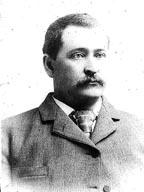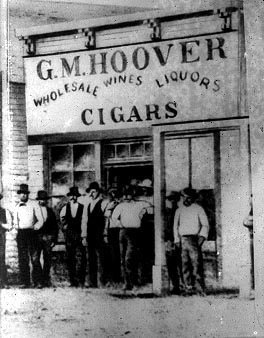One of the “Seven Old Timers” of Dodge City, KS
and First Merchant
George Merritt Hoover, one of Robert M. Wright’s “seven old timers” in his book, Dodge City, the Cowboy Capital (1913), was born in Canada on August 8, 1847, and arrived in Dodge City on June 17, 1872, becoming the second settler after Henry Sitler. With his business partner, John McDonald, he set up a sod-and-wood plank bar, the first Dodge City business, and sold whisky for 25 cents ($20.00 current value) a ladle full.


Hoover first located his saloon south of the tracks, moving into Front St. later (called “Main St.” in an early Hoover & McDonald Wines and Liquors ad). His business address in 1874 was “No. 36, Front St., Dodge City, Kas.” By the time he died in July 1914, he had amassed an estate of at least $500,000 (current value $5,000,000), leaving $100,000 of it to Dodge City, in addition to thousands of dollars more for churches and $10,000 to build Hoover Pavilion in Wright Park, Dodge City.
At his funeral, Ford County’s leading citizens gave honest praise to a man called “founder of Dodge” in the head line of his front-page Dodge City Globe obituary. Pioneer lawman H. B. (Ham) Bell said that “as I look back over the forty years of our acquaintance, the golden link in that long chain of years is that he named me Friend.” Lawyer L. J. Pettijohn called him “one of the best informed men that I have ever known.” And early Dodge City Mayor A.B. Gluck stated that “there was no hypocrisy or double-dealing in his [Hoover’s] makeup….he commanded the respect of all who came in contact with him.”
George M. Hoover was the second mayor (the first elected) of Dodge City. He was the founder and president of the State Bank of Dodge (now Fidelity State Bank). This bank, according to an early article by Heinie Schmidt, in the Dodge City Journal, August 8, 1929, “was the pride of his life, and in later years he directed all his attention to the same.” He was still president of the bank when he died.
Hoover served four terms as mayor, and was elected twice to the state legislature from Ford County. He was also county commissioner several times. Ross D. Hogue, an accountant in Dodge City, whose firm audited the Hoover Memorial fund that was set-up with the money left the city in Hoover’s will, wrote a long article in the Dodge City Daily Globe, September 4, 1950, about the Hoover Fund’s history. The total provided Dodge City over the many years since 1914 would be well over $500,000 dollars. This fund not only built Hoover Pavilion, but allowed the city to buy the airport in the early 1940s. At least by 1929, no other city in Kansas, according to Schmidt, had such a fund.
Hogue’s article continues; “In 1911, Dodge City adopted the commission form of government, and Hoover was elected the first mayor under this type of organization, along with John Miller and George E. Laughead as commissioners. In their first year of administration, they erected the first electric street lights in Dodge City and the first paving in the city was put in.”
Hoover was a devoted husband, entering McCarty Hospital March 14, 1914, a week after the death of his wife, Margaret (Carnahan) Hoover. They had married in 1875. She raised flowers and had a greenhouse at their home at 100 Military Ave., Dodge City (the corner of Central Avenue and Military–the road to Fort Dodge). The Hoovers raised a foster son, George Curry, who became one of the Roosevelt Rough Riders, and was first territorial governor of New Mexico.

Until his death, George Hoover never left the hospital after March, but for car rides with friends. He was 66 years old. He said, according to the July 16, 1914, Dodge City Globe, “that he had but little desire to live longer, and declared that life had no more interest for him [after his wife’s death].”
(© 2002, Ford County Historical Society, Inc. George Laughead, author.)
